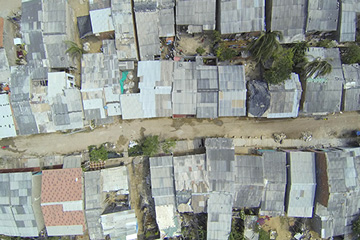The children play soccer barefoot on a dirt field, and when they aren’t imitating the flamboyant striking and passing skills of their country’s greatest footballers, they roam neighborhood streets, playing other games or sometimes just looking for something to eat.
If not for the efforts of a woman named Julia, many of them would go hungry. A 50-something community elder with an energetic spirit, Julia helps keep their bellies full, working with a group of other women to prepare meals that feed as many as 100 kids a day.
Life in some parts of Las Flores, a 5-square-mile shantytown near Barranquilla, Colombia, often presents a multitude of challenges. Food can be hard to come by; sewage, water, and electrical systems are nonexistent in most areas; and residents build shotgun-style homes with whatever materials they can find—in this case, mostly wood.
The local governments where slums like Las Flores are located see these places as eyesores, electing to leave them off of official maps. But two University of Miami School of Architecture professors, Carie Penabad and Adib Cure, believe slums should not only be recognized, but also given the assistance they need.
 So with tools as simple and archaic as pencil and paper, and as advanced and high-tech as camera-equipped drones, the husband-and-wife team has made its mission to map some of the poorest and most vulnerable places in the world.
So with tools as simple and archaic as pencil and paper, and as advanced and high-tech as camera-equipped drones, the husband-and-wife team has made its mission to map some of the poorest and most vulnerable places in the world.
They started in 2006, using traditional surveying techniques to map the slum of Shakha near Mumbai, India. The following year, they traveled to the Cape Town, South African township of Langa to map the informal settlement of Joe Slovo, one of the largest slums in that country. “Then we realized something,” recalls Penabad. “We’re based in Miami, and we’re traveling to the other side of the world to study these informal settlements, when, in fact, we have at our doorstep Latin America and the Caribbean, where an urban population is growing. So why not turn our focus closer to home.”
And they did, beginning with Las Flores. For every spring semester between 2008 and 2015, Penabad and Cure have taken students from their School of Architecture upper-level design studio, and starting two years ago software engineers from UM’s Center for Computational Science, to this 60-year-old settlement to map its 75 neighborhood blocks and seven barrios. While Christopher Mader and Amin Sarafraz from CCS operated the drones that produced highly detailed aerial maps of Las Flores, Penabad, Cure, and their students walked the streets, studying the slum’s building and construction patterns, peering into its simple wood and clay brick homes, observing neighborhood social interactions, and talking with some of the 10,000 residents who live there—all as part of an extensive effort to better understand the settlement’s structure and inner workings and, perhaps, help cure what ails it.
“When these cities that are literally off the map are documented and studied, you begin to not only understand them but get a much bigger picture of their problems,” said Penabad. “Where would it make the most sense to bring in water and sewer lines? Where are they disconnected in terms of transportation? Where would it make the most sense to build a medical clinic? The potential for progress becomes more tangible and possible when you can see everything mapped out.”
Penabad compares the maps to “X-rays that allow us to diagnose a settlement’s condition.”
Here’s what their “X-ray” of Las Flores shows: Newer barrios where small sheet-metal roofed houses are built so close together that hardly any light and fresh air penetrate, older districts where, over time, wooden houses have been replaced by concrete homes, few if any public gathering spaces, and unpaved streets.
Las Flores is compact, mirroring on-the-grid Barranquilla only in having a clearly delineated pattern of streets and blocks. “Houses come up to the edges of streets,” explains Penabad, “and there aren’t many automobiles, so people walk to get to where they need to go.”
Usually where they need to go is to the larger metropolis, where shantytown residents frequently work in factories and hotels. Some of the women toil as housemaids. Only Penabad and Cure’s direct interaction with residents reveals that aspect of life in Las Flores, making their on-the-ground research just as eye-opening—and important—as the images the drones produce. What that research has shown is that Las Flores and many other such slums are surprisingly sustainable.
“There’s a well-structured network of families,” said Cure. “Older, more established families usually become the leaders, creating daycare centers and micro businesses that help the community.” One woman, he notes, even started a mobile clothes-washing service, wheeling a portable manual washing machine door to door.
“Everyone living in an urban slum isn’t necessarily worse off,” said Justin Stoler, an assistant professor of geography and regional studies in UM’s College of Arts and Sciences, whose own research on informal settlements has taken him to Accra, Ghana, to explore links between neighborhoods, the environment, and human health. “Living in a slum has been shown to not only hinder growth, but sometimes aid it via tight-knit communities that offer better resilience for overcoming stressors, and communities where residents take care of one another and provide buffers from all the problems they’re dealing with on a daily basis.”
Penabad and Cure’s goal is to make UM a center for the collection of data on informal settlements throughout Latin America. “We’ve found a way to map these in a pretty distinct way,” Penabad explains. “We’d like to acquire enough funding to deploy this toolkit more systematically and make it entirely open-sourced.”

